Rafael Cohen, a Turkish Sephardic Jew in Smyrna (now Izmir), sent letters about Jewish life in his city to the Spanish senator Ángel Pulido in the early 1900s. According to Pulido, Cohen was a language teacher who also worked for the Turkish Jewish newspaper El Messeret. Excerpts of his letters appear in Pulido’s second book about Sephardic Jews, published in 1905, whose title we could translate as Spaniards without a Country and the Sephardic Race.
Cohen writes that some Turkish Sephardim found it hard to believe that their language (Judeo-Spanish, also called Ladino, Judezmo, etc., which they wrote in the Hebrew alphabet) was a form of Spanish. But when he would hand them a newspaper from Spain, they generally found that even with their limited knowledge of the Latin alphabet, they could understand what they were reading.
In a letter dated September 8, 1904, he recalls:
Recently, one of them said to me, “Is it true that what we speak is a European language? Isn’t what we speak Judezmo?” I responded by handing him an issue of El Liberal. He laughed and began reading it and replied with great amazement, “This is one Spanish and ours is another…” Who could help feeling heartbroken at that reaction? I laughed ruefully and my heart ached at seeing a people, my people, speaking the most beautiful language without knowing, or rather without realizing, what they were speaking…
Cohen, something of a language purist, was one of the era’s Sephardim who advocated making Continue reading


